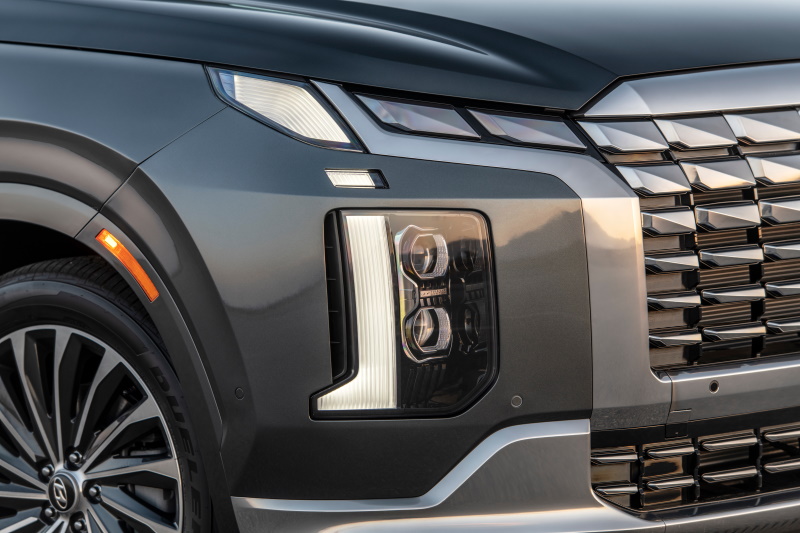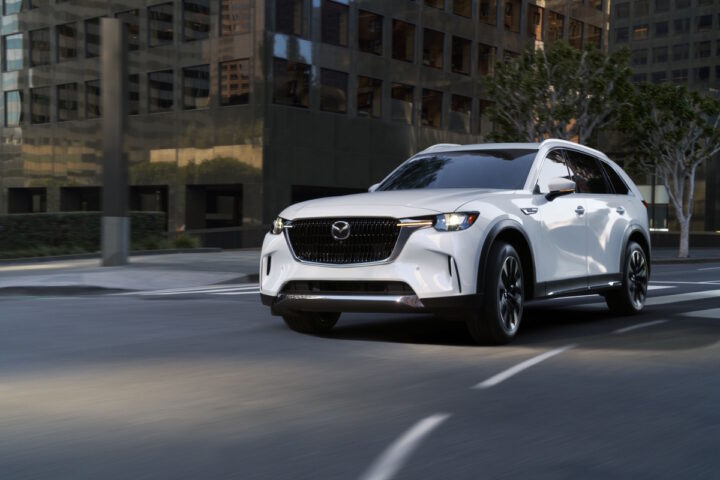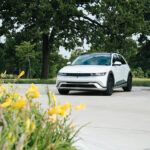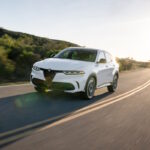by Anthony Fongaro – Photos via Hyundai- 12/26/2022
We will start with the rear end. There are two sloping taillights, a big Hyundai badge, and a Palisade written across the tailgate. You’ll see a small HTRAC badge on the lower right of the trunk. Below the trunk are silver trim and two exhaust pipes. Calligraphy Exclusive 20-inch Alloy Wheels, Moonlight Cloud paint, and some silver and black trim pieces adorn the exterior. Side mirrors have an interesting design for the turn indicators and a silver trim on the door handles. As a refresh, the biggest change is at the front. For some reason, Hyundai decided to make the grille the entire length of the front end. This is a controversial design since it looks like a pickup truck. It has a waterfall-like design and within the left and right of the design are your slim turn indicators and lights. Palisade is a great-looking crossover SUV. The combination of the Moonlight Cloud paint and 20-inch wheels makes this Palisade stand out.
When you step inside, you’re greeted with a Light Beige interior. There are also some contrasting black plastics and silver paddle shifters near the gray and white steering wheel. As you get in, you will know notice the Hyundai steering wheel which has buttons for the adaptive cruise control and media. Above is a head-up display with information pertaining to your speed, speed limit, and navigation. To the right of the driver is a large 12.3-inch infotainment system that has Apple CarPlay and Android Auto. One of the interesting features is something called Passenger Talk. Passenger Talk uses a microphone that will pick up a driver’s voice and play it through the rear speakers. Palisade Caligraphy also has a great-sounding Harman/Kardon stereo.
Below the infotainment system are hard buttons for the navigation system and media. There are some knobs for climate control, but it mainly utilizes a touchscreen for the fan. It’s not difficult to use, but it would be nice if all of these were traditional buttons and knobs. Palisade uses buttons for the transmission with an auto hold button next to the transmission buttons. A knob for the driver select includes smart, sport, comfort, eco, and snow. There is also a lock button for the differential. I will go into the drive modes when I talk about driving the Palisade. Top-of-the-line Palisade Caligraphy comes with heated and ventilated in the front and middle rows, along with a heated steering wheel. The cup holders are very large and can swivel so you can put bigger items in the area. There is also a little space for wireless charging. I really do like the ambient lighting in the Palisade along with the white wood grain trim.
Onto the middle row is two captain chairs. You’ll see physical buttons for your heated and ventilated seats, along with buttons for your temperature. There are USB ports on the back of the front chairs with the cup holders located in the doors. This model also came equipped with manual sunshades and a rear glass roof. You’ll note that the front and second rows are quite comfortable, with the driver side having an ergo motion massage feature which does a decent job. Getting in the back of the Palisade is not difficult and unsurprising, the rear seats are not as comfortable as the front.
That said because there is so much room in the Palisade that leg space is good. You’ll find a large trunk that is power-operated. Lowering or raising the second and third-row seats is simple since there are convenient buttons that have the seats lie completely flat. There is no load lip, and of course, the Palisade’s tailgate is automatic. The one thing I did not like was in inclement weather, the backup camera and 360-degree camera are exposed. Getting snow or rain on their sensors or cameras result in low visibility.
Powering all Palisades is Hyundai’s 3.8-liter naturally-aspirated V6 producing 291 horsepower/214 kW and 262 lb-ft/355 Nm. A 0-60 MPH run of 6.8 seconds is thanks to the eight-speed automatic transmission along with an all-wheel-drive system. During a small snowstorm, using that snow mode made driving the Palisade a doddle. I would usually drive the Palisade in comfort, while sport mode helped to utilize all of the Palisade’s power. Kick-down from the eight-speed automatic was good and I never wanted more power. Even for a large three-row SUV, doing simple maneuvers was easy. Driving was helped with adaptive cruise control and blind-spot monitoring. The average fuel economy was around 18-20 MPG. I’m sure in the future there will be some kind of hybrid with better fuel economy.
Pricing for Palisade models is quite simple. Base price SE models start at $35,000 with the top-of-the-line Caligraphy costing $50,000. At that price, you get every piece of tech. Included is the large infotainment system, Hyundai’s safety system, heated and ventilated front, and rear seats, along with Nappa seats. While the SEL trim level is a great value at $38,000, I’d recommend this posh trim. It’s definitely on par with high-end competitors. There’s a feeling of quality inside the Palisade along with great materials.
I understand why the Hyundai Palisade is at the top of the charts. They’ve been replacing minivans and crossover SUVs from domestic, German, and Japanese brands. Hyundai isn’t just about cost-effective vehicles. With the Palisade, Hyundai showcases that $50,000 gets you a top-notch crossover. The fuel economy might not be the best, but it excels in just about everything else. If you’re looking for a family-friendly crossover, the Hyundai Palisade should be at the top of your list.























